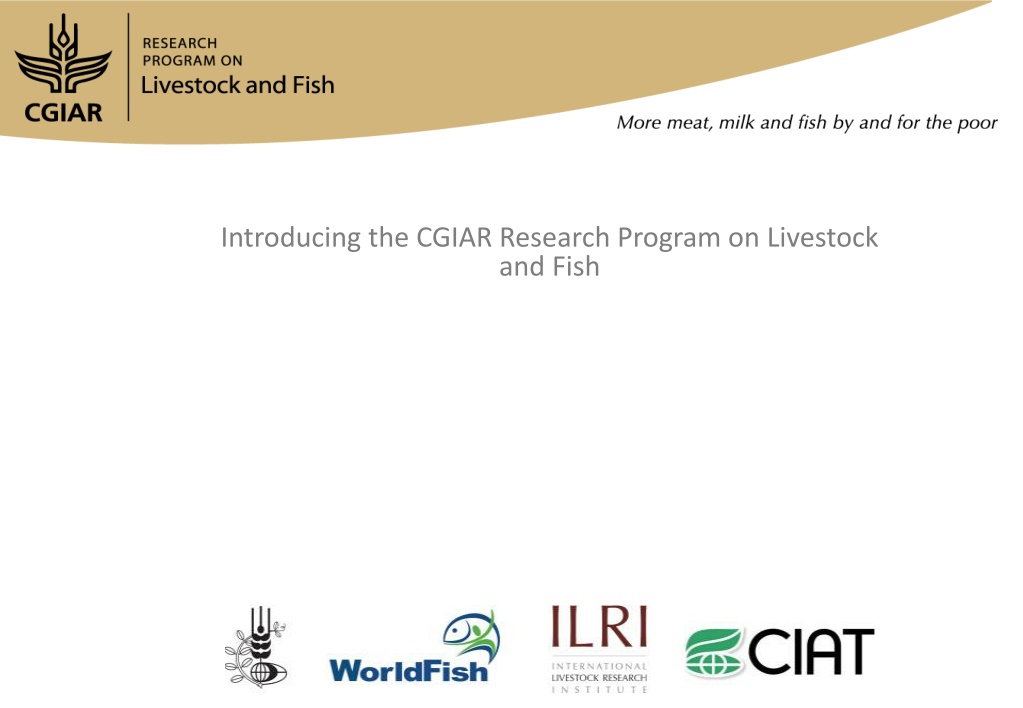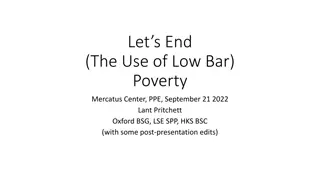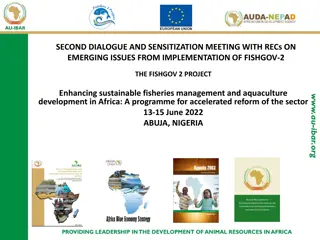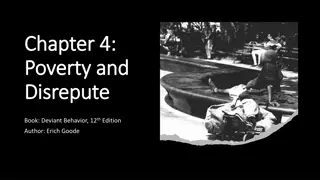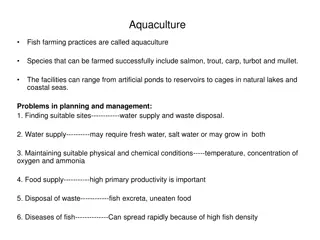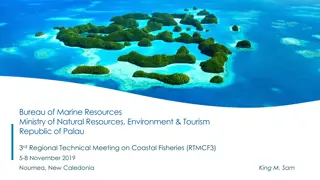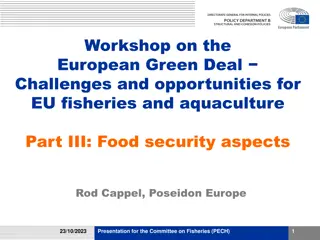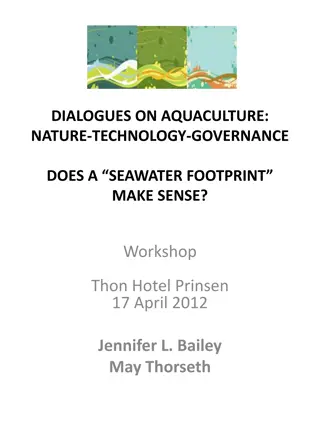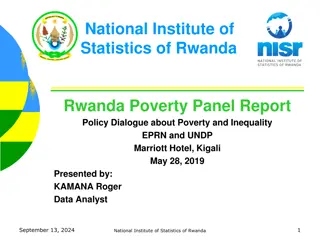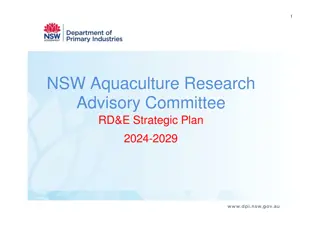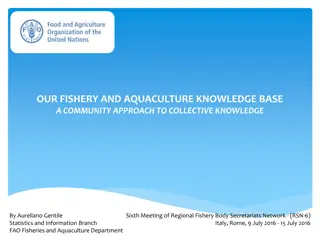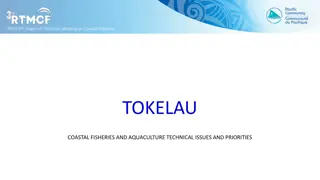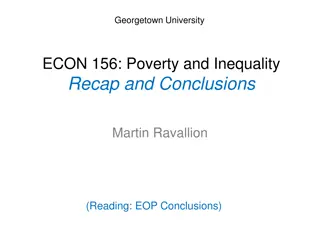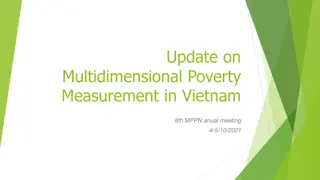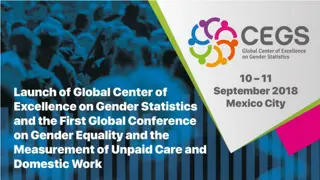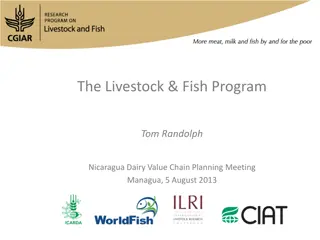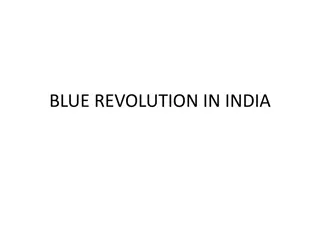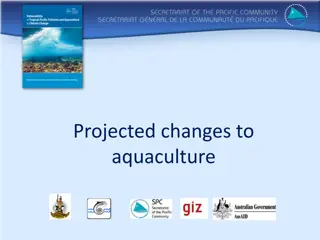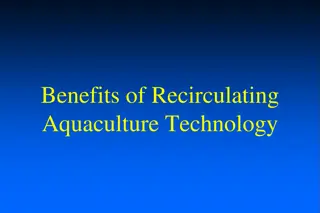Accelerating Livestock and Aquaculture Development for Poverty Reduction
The CGIAR Research Program on Livestock and Fish aims to address the challenges and misconceptions surrounding livestock and aquaculture development. It focuses on increasing productivity in small-scale systems to benefit the poor and improve food security. The program seeks to correct misconceptions, manage the transition for smallholder households in developing countries, and bridge the productivity gap despite past investments in livestock development.
Download Presentation

Please find below an Image/Link to download the presentation.
The content on the website is provided AS IS for your information and personal use only. It may not be sold, licensed, or shared on other websites without obtaining consent from the author. Download presentation by click this link. If you encounter any issues during the download, it is possible that the publisher has removed the file from their server.
E N D
Presentation Transcript
Introducing the CGIAR Research Program on Livestock and Fish
The challenge Can research accelerate livestock and aquaculture development to benefit the poor? o Mixed record to date o Systematic under-investment o Also related to our research-for-development model? Focus of new CGIAR Research Program o Increase productivity of small-scale systems o by the poor poverty reduction o for the poor food security
Correcting perceptions 1. Animal-source foods are a luxury and bad for health, so should not promote 2. Small-scale production and marketing systems are disappearing; sector is quickly industrializing 3. Livestock and aquaculture development will have negative environmental impacts
Our underlying hypothesis Livestock and Blue Revolutions: accelerating demand in developing countries as urbanization and incomes rise Industrial systems will provide a large part of the needed increase in supply to cities and the better-off in some places But the poor will often continue to rely on small-scale production and marketing systems If able to respond, they could contribute, both increasing supplies and reducing poverty and better manage the transition for many smallholder households
Managing the transition Estimates for smallholders in Africa and Latin America (Wiggins 2012; Dorward 2009) : 1/3 Will step up to become commercial farmers 1/3 Will step out and work for other, go to the city 1/3 Could go either way Can 2/3 be enabled to develop into commercial producers, accumulate capital and transition out of agriculture? deeper rural economic growth avoid social disruption (Johnston et al. 1995)
But productivity gap remains despite investment in livestock development Meat (kg output/kg biomass/yr) 0.2 1980 2005 0.17 0.11 0.08 0.06 0.06 0.04 0.03 Africa Latin America South Asia Industrialized Countries Biomass is calculated as inventory x average liveweight. Output is given as carcass weight. Source: (Steinfeld et al 2006)
But productivity gap remains despite investment in livestock development (2) Milk (kg/cow/yr) 6350 1980 2005 4226 1380 1021 904 517 411 397 Africa Latin America South Asia Industrialized Countries Source: (Steinfeld et al 2006)
Aquaculture lagging too annual growth rate of aquaculture 2007-2015 needed to satisfy fish demand source: Cai (2011)
A smarter approach? Drawing from recent experiences, can we accelerate research to impact? Objective of new CGIAR Research Program on Livestock and Fish
Goal To sustainably increase the productivity of small-scale livestock and fish systems to increase the availability and affordability of animal-source foods for poor consumers and, in doing so, reduce poverty through greater participation by the poor along the whole value chains for animal-source foods.
Basic Idea: Solution-driven R4D to achieve impact Traditional approach was piecemeal Past research has focused specific aspects of given value chains, commodities and country. Consumers Inputs & Services Production Processing Marketing ...in Country A Consumers Inputs & Services Production Processing Marketing ...in Country B Consumers Inputs & Services Production Processing Marketing ...in Country C Consumers Inputs & Services Production Processing Marketing ...in Country D
Approach: Solution-driven R4D to achieve impact #1: Addressing the whole value chain R4D integrated to transform selected value chains In targeted commodities and countries. Consumers Inputs & Services Production Processing Marketing Major intervention with development partners Value chain development team + research partners Strategic CRP 3.7 Cross-cutting Platforms Technology Generation Market Innovation Targeting & Impact INTERVENTIONS TO SCALE OUT REGIONALLY GLOBAL RESEARCH PUBLIC GOODS
Adopting a broad scope for an animal-source food value chain Figure from N Taylor
A generic livestock value chain A value chain is the set of actors, transactions, information flows, and institutions that enable value to be delivered to the customer (Baker 2007) N Taylor
Approach: Solution-driven R4D to achieve impact #2: Working toward interventions for impact at scale Performance Target: double production in x poor households CRP3.7 Prepare intervention Scaling out Development Partners $90m Knowledge Partners $10m CRP3.7 Strategic Research $10m Time 10 years
Approach: Solution-driven R4D to achieve impact #3: Focus on 9 target value chains
Delivering the Program Structure: Six integrated components 5 Targeting: Foresight, prioritization, environmental impacts 4Value chain development Technology development: 1 Health 2 Genetics 3 Feeds Inputs & Services Production Processing Marketing Consumers Commodity X in Country Y 6Cross-cutting: gender, impact, M&E, comms, capacity building
Status Partnership of 4 CGIAR Centers ILRI WorldFish Center CIAT ICARDA Officially started January 1st, 2012 Engaging with partners Consolidating ongoing activities, and developing strategy by component and value chain
The Value Chain Development Component: Working toward interventions for impact at scale Engagement Assessment Piloting Validating Learning at scale Tackling the harder constraints Time 10 years
Engagement / Assessment Engagement Scoping R&D partners Stakeholder event Catalyze alliance Assessment Reviews Tool development Site selection Rapid VC assessment Situational analysis Framework for assessing VC performance Identify best-bet intervention Assessment Reviews Tool development Rapid VC assessment Situational analysis Identify best-bet intervention In-depth VC assessment In-depth VC assessment 2nd year 3rd year 1st year Time
Piloting / Validating Piloting Baseline studies Action-research trials Validating Field trials 2nd year 3rd year 1st year Time
Approach: Solution-driven R4D to achieve impact How we are visioning the evolving roles of development partnership Along the Impact Pathway Relative degree of involvement Research partners Knowledge partner Experiments Evaluation Evidence Attracting investment Assessment Mobilization Best bets Implementing large-scale interventions Design Piloting Lessons Context Advocacy Dissemination Development partners Year 1 Program horizon in a target value chain Year 8-12
Approach: Solution-driven R4D to achieve impact Different types of partners will be needed Relative degree of involvement Research partners Universities CGIAR NARS ARIs Media International NGOs Consumer lobbies Private Sector SMSE Commercial Producer organizations Local NGO/CBOs Community development Livestock/aquaculture Inputs/services Development partners Year 1 Program horizon in a target value chain Year 8-12
Approach: Solution-driven R4D to achieve impact Different modalities Relative degree of involvement Research partners Work as an alliance with common objective Establish long-term strategic partnership Universities CGIAR NARS ARIs Media International NGOs Consumer lobbies Private Sector SMSE Commercial Producer organizations Local NGO/CBOs Community development Livestock/aquaculture Inputs/services Development partners Year 1 Program horizon in a target value chain Year 8-12
3-year budget by Center $7,113 $3,183 $25,195 CIAT ICARDA ILRI World Fish $64,091 TOTAL = US$99.6 million
3-year budget by Component Program Management $5.6m TOTAL Approved = US$99.6m 2/3 s funding secured Institutional Overhead $16.3m Targeting, Gender and Impact $13.3m Technology Development $43.3m Value Chain Development $20.9m TOTAL = US$99.6 million
CGIAR Research Program on Livestock and Fish livestockfish.cgiar.org livestockfish.cgiar.org CGIAR is a global partnership that unites organizations engaged in research for a food secure future. The CGIAR Research Program on Livestock and Fish aims to increase the productivity of small-scale livestock and fish systems in sustainable ways, making meat, milk and fish more available and affordable across the developing world.
